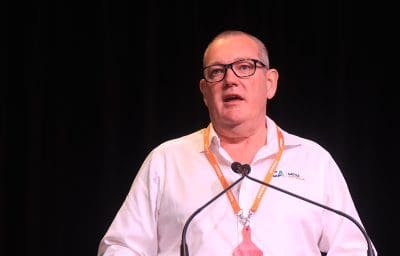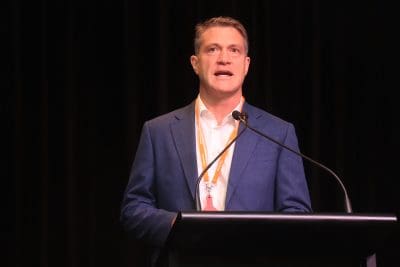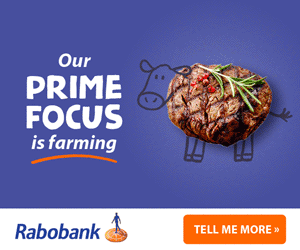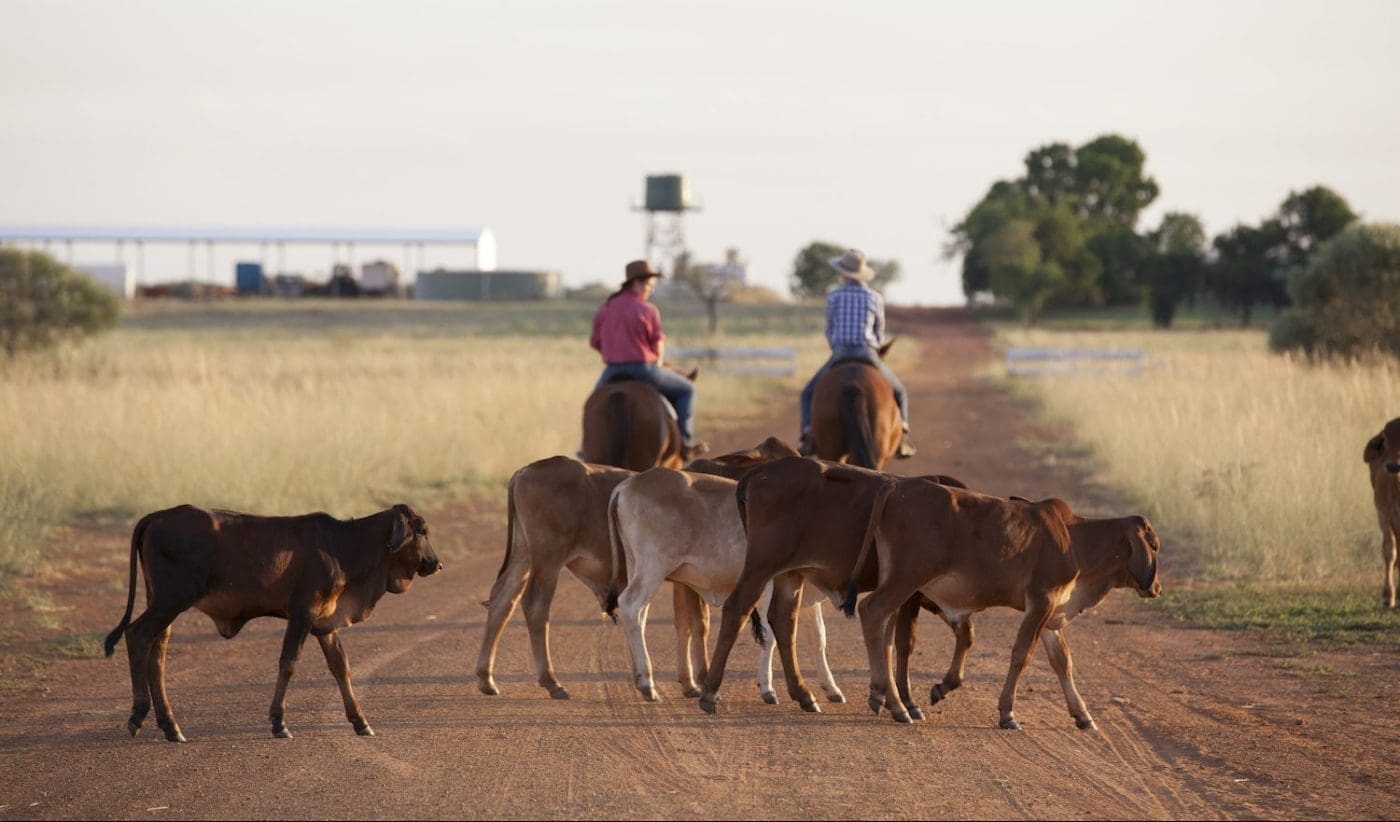CATTLE Australia says it hopes to have a definition of deforestation across the supply chain in the Australian context ready for launch at Beef 2024.
It comes amid a ramping up of sustainability reporting requirements across global suply chains, of which Rabobank economist and senior analyst Angus Gidley-Baird provided a comprehensive and confronting summary at the NTCA annual conference in Alice Springs last week (more detail below).
Deforestation definition
Cattle Australia committed to creating national land management and biodiversity standards for beef production in December (link to earlier story here) following a meeting of more than 50 industry leaders from across the supply chain in Rockhampton.
 At the time Cattle Australia CEO, Dr Chris Parker, said the sector recognised it needed to be part of the solution in providing a clear, evidence-based definition of deforestation and biodiversity the reflects the uniqueness of the Australian landscape.
At the time Cattle Australia CEO, Dr Chris Parker, said the sector recognised it needed to be part of the solution in providing a clear, evidence-based definition of deforestation and biodiversity the reflects the uniqueness of the Australian landscape.
“It’s just not feasible to compare Australia’s land management practices for beef production with other jurisdictions, so we need to develop fit-for-purpose, regionally specific indicators for global reporting that recognise our inherent ecological differences.”
Speaking at the NTCA conference last Friday, Dr Parker said the process to date has built on the meeting in Rockhampton and engagement with supply chain members and the employment of a consultant to finalise the Australia-industry specific definition.
He said the definition is be developed for use across the entire Australian supply chain, spanning not just producers, saleyards, feedlots and processors but also retailers, supermarkets and banks.
Having the same approach across the entire supply chain was key, Dr Parker said.
Non-financial disclosure requirements ramping up
The same conference was also given a comprehensive rundown of the various ways in which pressure to provide more quantifiable, objective reporting on sustainability progress is increasing across global supply chains.
 “Sustainability has been a topic for us for at least the last five years, but in the last couple of months in particular there is quite a major internal process at the moment that is going on that is sucking up a lot of my time and a lot of it centres around this non-financial disclosure space,” Rabobank economist and senior analyst Angus Gidley-Baird said.
“Sustainability has been a topic for us for at least the last five years, but in the last couple of months in particular there is quite a major internal process at the moment that is going on that is sucking up a lot of my time and a lot of it centres around this non-financial disclosure space,” Rabobank economist and senior analyst Angus Gidley-Baird said.
“The information that is being asked of operators and supply chains and then how they can actually report on that is becoming very, very important.”
Non-financial disclosures are a form of transparency reporting in which businesses formally disclose certain information not related to their finances.
It is also referred to as sustainability, or ESG (Environment, Social and Governance) reporting.
Several examples of guidelines and metrics already in place or being developed across Government, industry and the supply chain included:
- The Australian Government has signed up to the Global Methane Pledge (which aims to reduce emissions by at least 30pc from 2020 levels by 2030), the Paris Agreement (with a goal to limit global average temperature increases to below 1.5°C above pre-industrial levels), and the Global Biodiversity Framework which sets 23 targets for 2030and a further four goals for 2050.
 The red meat industry has committed to achieving a goal of carbon neutrality by 2030 or CN30, which means Australia’s red meat and livestock industry will make no net release of greenhouse gas (GHG) emissions into the atmosphere by 2030.
The red meat industry has committed to achieving a goal of carbon neutrality by 2030 or CN30, which means Australia’s red meat and livestock industry will make no net release of greenhouse gas (GHG) emissions into the atmosphere by 2030.- The Red Meat Advisory Council appointed Sustainable Steering Group puts out an Australian Beef Sustainability Framework annual report with updates on key indicators and metrics reflecting the industry’s progress towards achieving sustainability goals.
- The Australian Government has also supported the Taskforce on Nature-related Financial Disclosures (TNFD), which has developed a set of disclosure recommendations and guidance designed to support a shift in global financial flows away from nature-negative outcomes and toward nature-positive outcomes.
Financial institutions are increasingly being seen as a conduit or catalyst to align financial flows with sustainability outcomes, given the influence they are seen to have on other operators in the value chain.
“The Australian Government is seeing the role of financial institutions in terms of reporting and collecting this information to demonstrate progress and the impacts from a nature and sustainability point of view,” Mr Gidley Baird said.
“At the same time banks are not excused from NGO activity and scrutiny either.”
Climage group succeeding through legal action
In one recent example, climate group Friends of the Earth has initiated legal action against ING, which it labelled the “banker of the climate crisis”, seeking to force it cuts its emissions in half by 2030 compared to 2019 levels.
The lawsuit comes despite ING having laid out plans in December last year to phase out its financing of oil and gas development projects by 2040.
Friends of the Earth previously won a landmark climate court case against Shell in 2021, which resulted in a European court ordering the fuel giant to reduce its greenhouse gas emissions by 45 percent by the end of 2030.
A little closer to home, last September the Australian Conservation Foundation commissioned research by Ernst and Young which claimed that $260 billion of all outstanding bank loans, or 22pc of bank lending, is to sectors that carry a “high risk of impacting nature”.
The report went further and singled out livestock agriculture, which holds $47bn of outstanding loans from leading Australian banks, as “the subsector responsible for the biggest impact on nature” and recommended that banks “adopt no-deforestation policies” in lending criteria.
Mr Gidley-Baird said it was important to be aware of the pressures being generated on various members of its supply chain.
“We have got on one hand the Governments with their regulatory tools, we’ve got companies making commitments and reporting, and we’ve got industry setting targets and making commitments and starting to report.
“On the other hand we have got the investors, we’ve got the shareholders, we’ve got the NGOs and we’ve got the general public looking for some sort of certainty or demonstration of progress in that space, and some sort or certification or reassurance that the information is genuine.”
Objective, quantifiable measures now being sought
A lot more work was now being seen in the non-financial reporting space focused on demonstrating progress toward targets in a way that ensures there is confidence in the system and avoids claims about greenwashing.
“The level of activity we have seen in the last two years is only ramping up and getting faster,” he said.
In January last year in Europe, the EU Corporate Sustainability Reporting Directive (CSRD) entered into force, which requires large companies and listed companies to publish regular reports on the social and environmental risks they face, and on how their activities impact people and the environment.
In June last the Australian Treasured announced its proposal to implement mandatory climate-related financial disclosures to require large companies report on their climate, environmental and sustainability related progress. It is yet to go before parliament but, if passed in coming months in its current form, it will require companies with over $500m in consolidated revenue each year to mandatorily report on climate impacts from July this year, and companies with revenue of more than $50m per year from July 2027.
Larger companies will seek reporting from smaller supply chain partners
While most individual cattle producers will not be directly affected, many of their downstream partners in the value chain would be required to undertake mandatory reporting of scope 1, scope 2 and scope 3 emissions.
Scope 1 emissions are direct emissions deemed to be totally within your control, Scope 2 are emissions generated from the energy you are utilising in your operations, and Scope 3 are the emissions created by those in the supply chain that you don’t have a control over.
“So for most of you in the room as producers, your scope 1 emissions that are generated out of your operations are the Scope 3 emissions for the retailer or for the processor or for the financial institution out there.”
He said that as part of the value chain, producers are going to start to see an increasing amount of interest from other operators in the value chain about how they can collect information to be able to demonstrate they are meeting their commitments or to demonstrate their impact from an environmental or a sustainability point of view.
CN30 target “a stake in the sand”
Mr Gidley Baird said the CN30 goal had put a stake in the sand that had given a lot of operators in the supply chain the confidence to know that the industry is progressing towards something.
“I think the opportunity lies here in looking through, and it is unfortunately one of those mundane processes, we’re trying to figure out what the metrics are, what the best way of measuring it is, because the ability to influence and create a positive outcome is there.
“The problem is if you don’t do it, someone else is going to decide.”
He said industry had a great opportunity to try and lead some of the conversation in this space.
The non-financial disclosures guidelines released last year stated that “the close coupling of nature and agriculture not only means the agricultural sector is a driver of negative ecosystem impacts, but it also holds the key to the transition to nature positive outcomes”.
“As landholder you are one of the most important operators in this whole system,” Mr Gidley-Baird said.
“You can potentially have a big role to play in this.
“And while a lot of it might seem that the first part of that sentence is coming at us in a negative way, the opportunity to actually participate in a positive way exists as well.
He said the industry faces a challenge in how to participate in the conversation to achieve a positive outcome.
“Because I daresay if you don’t participate in this process there are enough commitments and enough things going on that are going to come at you in some form or another.”

